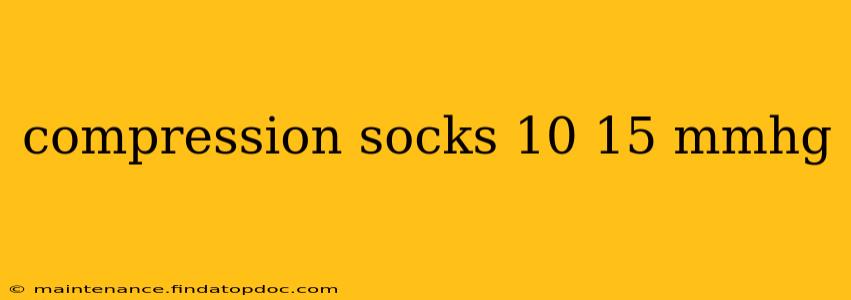Compression socks, specifically those offering 10-15 mmHg of compression, are a popular choice for many individuals seeking relief from various leg-related discomforts. But what exactly does 10-15 mmHg mean, and are they right for you? This comprehensive guide will delve into the specifics of 10-15 mmHg compression socks, exploring their benefits, uses, and considerations.
What Does 10-15 mmHg Compression Mean?
The mmHg (millimeters of mercury) rating indicates the amount of pressure the socks exert on your legs. A 10-15 mmHg compression level is considered light compression. This means the pressure is gentle, improving circulation without being overly constricting. It's significantly lower than the compression levels used for medical conditions requiring stronger support (e.g., 20-30 mmHg or higher).
Who Should Wear 10-15 mmHg Compression Socks?
These socks are generally suitable for individuals experiencing mild leg discomfort related to:
- Long periods of standing or sitting: People who work long shifts on their feet or spend extended hours seated may find relief from the associated leg fatigue and swelling.
- Mild swelling (edema): Light compression can help manage minor swelling in the legs and ankles, often associated with prolonged standing or travel.
- Varicose veins (mild cases): While not a cure for varicose veins, 10-15 mmHg compression can provide support and alleviate some of the associated discomfort. Severe varicose veins require medical attention and potentially higher compression levels.
- Post-exercise recovery: Wearing these socks after physical activity can help reduce muscle soreness and swelling.
- Travel: Long flights or car journeys can restrict blood flow, leading to leg swelling and discomfort. Light compression socks can mitigate these issues.
What Are the Benefits of 10-15 mmHg Compression Socks?
The primary benefits of 10-15 mmHg compression socks include:
- Improved Circulation: Gentle compression helps promote blood flow back to the heart, reducing swelling and fatigue.
- Reduced Leg Swelling: By supporting the veins and capillaries, these socks minimize fluid accumulation in the lower legs.
- Enhanced Muscle Recovery: They can help reduce muscle soreness and speed up recovery after exercise.
- Increased Energy Levels: Improved circulation can lead to a feeling of increased energy and reduced leg heaviness.
- Comfort and Support: They provide a comfortable level of support without feeling overly tight or restrictive.
Are 10-15 mmHg Compression Socks Right for Me?
This compression level is generally safe for most people, but it's essential to consult your doctor or physician if you have:
- Severe medical conditions: Pre-existing conditions like heart disease, peripheral artery disease (PAD), or deep vein thrombosis (DVT) require careful consideration and medical advice before using compression socks.
- Significant leg swelling: If you experience severe or sudden swelling in your legs, consult a doctor to rule out underlying medical issues.
- Skin conditions: Individuals with sensitive skin or skin conditions should carefully consider material and choose breathable fabrics to avoid irritation.
How to Choose the Right 10-15 mmHg Compression Socks?
When selecting 10-15 mmHg compression socks, consider:
- Material: Opt for breathable, moisture-wicking fabrics like cotton, nylon, or blends for optimal comfort.
- Size and Fit: Ensure a proper fit to maximize effectiveness and comfort. Follow the manufacturer's sizing chart carefully.
- Length: Choose the length appropriate for your needs – ankle, calf, or thigh-high.
- Features: Some socks offer additional features like seamless toes to reduce friction or graduated compression for enhanced comfort and support.
How Tight Should 10-15 mmHg Compression Socks Feel?
They should provide a snug, comfortable fit without feeling overly tight or constricting. You shouldn't experience any numbness, tingling, or excessive discomfort. If you experience any of these symptoms, remove the socks immediately and consult your doctor.
Can I Wear 10-15 mmHg Compression Socks All Day?
While generally safe to wear for extended periods, consider removing them periodically to allow for better blood circulation. Listen to your body and remove them if you experience any discomfort.
Where Can I Buy 10-15 mmHg Compression Socks?
Compression socks are readily available online and in many pharmacies, medical supply stores, and sporting goods retailers. Be sure to verify the compression level before purchasing to ensure you're getting the appropriate support.
This information is for general knowledge and does not constitute medical advice. Always consult with your healthcare provider before using compression socks, particularly if you have any pre-existing health conditions. They can help determine the appropriate compression level and ensure the socks are suitable for your individual needs.
